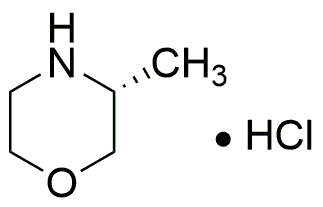(R)-3-Methylmorpholine hydrochloride is widely utilized in research focused on:
- Pharmaceutical Development: This compound serves as a building block in the synthesis of various pharmaceuticals, particularly in the development of analgesics and anti-inflammatory drugs.
- Chemical Synthesis: It is employed as a reagent in organic synthesis, facilitating the formation of complex molecules, which is essential in both academic and industrial laboratories.
- Biochemical Research: Researchers use it to study enzyme activity and protein interactions, providing insights into biological processes and potential therapeutic targets.
- Polymer Production: The compound is used in the production of specialty polymers, enhancing properties like flexibility and durability, which are crucial in materials science.
- Agrochemical Formulations: It acts as an intermediate in the synthesis of agrochemicals, contributing to the development of effective pesticides and herbicides.
General Information
Properties
Safety and Regulations
Applications
(R)-3-Methylmorpholine hydrochloride is widely utilized in research focused on:
- Pharmaceutical Development: This compound serves as a building block in the synthesis of various pharmaceuticals, particularly in the development of analgesics and anti-inflammatory drugs.
- Chemical Synthesis: It is employed as a reagent in organic synthesis, facilitating the formation of complex molecules, which is essential in both academic and industrial laboratories.
- Biochemical Research: Researchers use it to study enzyme activity and protein interactions, providing insights into biological processes and potential therapeutic targets.
- Polymer Production: The compound is used in the production of specialty polymers, enhancing properties like flexibility and durability, which are crucial in materials science.
- Agrochemical Formulations: It acts as an intermediate in the synthesis of agrochemicals, contributing to the development of effective pesticides and herbicides.
Documents
Safety Data Sheets (SDS)
The SDS provides comprehensive safety information on handling, storage, and disposal of the product.
Product Specification (PS)
The PS provides a comprehensive breakdown of the product’s properties, including chemical composition, physical state, purity, and storage requirements. It also details acceptable quality ranges and the product's intended applications.
Certificates of Analysis (COA)
Search for Certificates of Analysis (COA) by entering the products Lot Number. Lot and Batch Numbers can be found on a product’s label following the words ‘Lot’ or ‘Batch’.
*Catalog Number
*Lot Number
Certificates Of Origin (COO)
This COO confirms the country where the product was manufactured, and also details the materials and components used in it and whether it is derived from natural, synthetic, or other specific sources. This certificate may be required for customs, trade, and regulatory compliance.
*Catalog Number
*Lot Number
Safety Data Sheets (SDS)
The SDS provides comprehensive safety information on handling, storage, and disposal of the product.
DownloadProduct Specification (PS)
The PS provides a comprehensive breakdown of the product’s properties, including chemical composition, physical state, purity, and storage requirements. It also details acceptable quality ranges and the product's intended applications.
DownloadCertificates of Analysis (COA)
Search for Certificates of Analysis (COA) by entering the products Lot Number. Lot and Batch Numbers can be found on a product’s label following the words ‘Lot’ or ‘Batch’.
*Catalog Number
*Lot Number
Certificates Of Origin (COO)
This COO confirms the country where the product was manufactured, and also details the materials and components used in it and whether it is derived from natural, synthetic, or other specific sources. This certificate may be required for customs, trade, and regulatory compliance.


